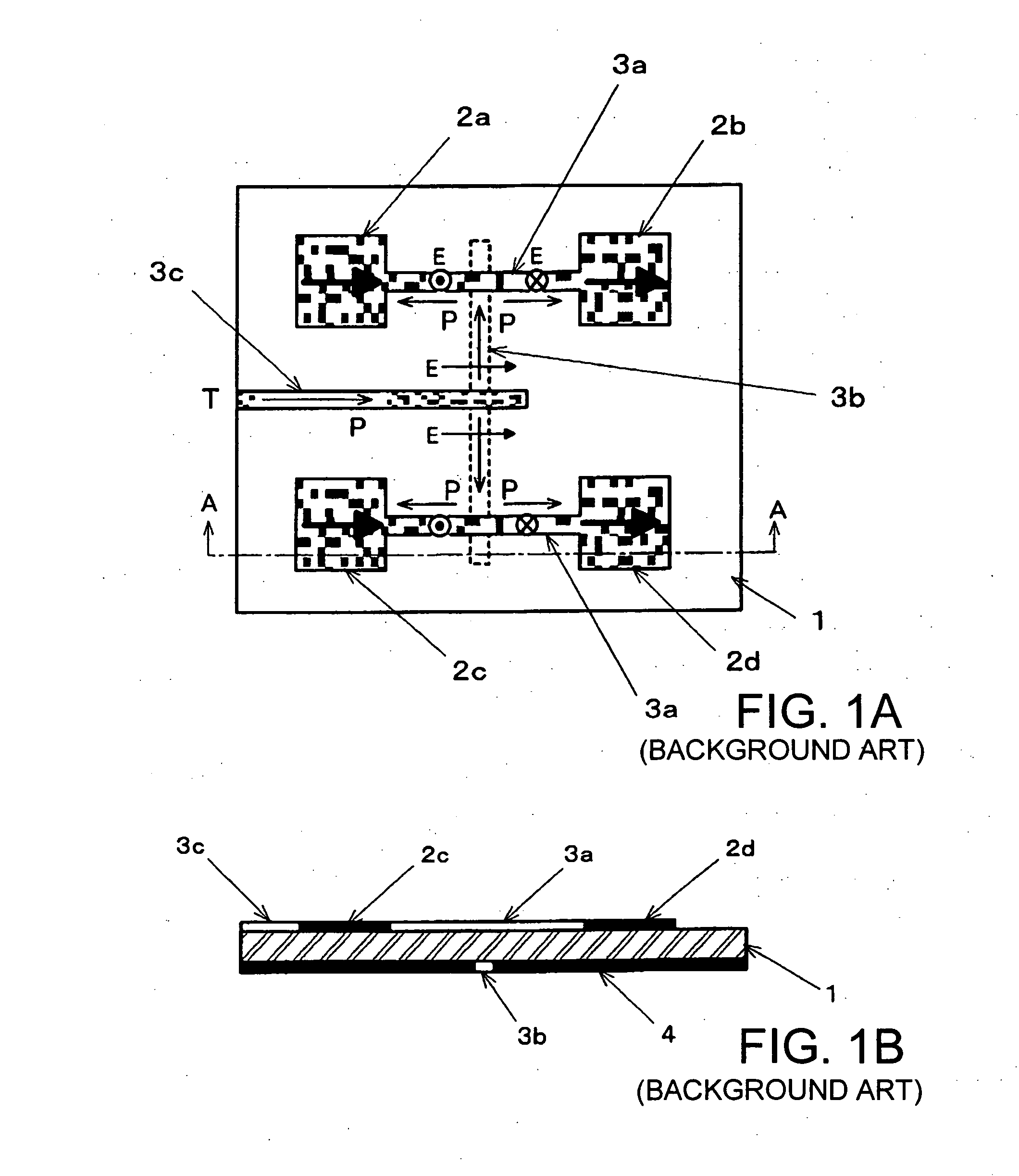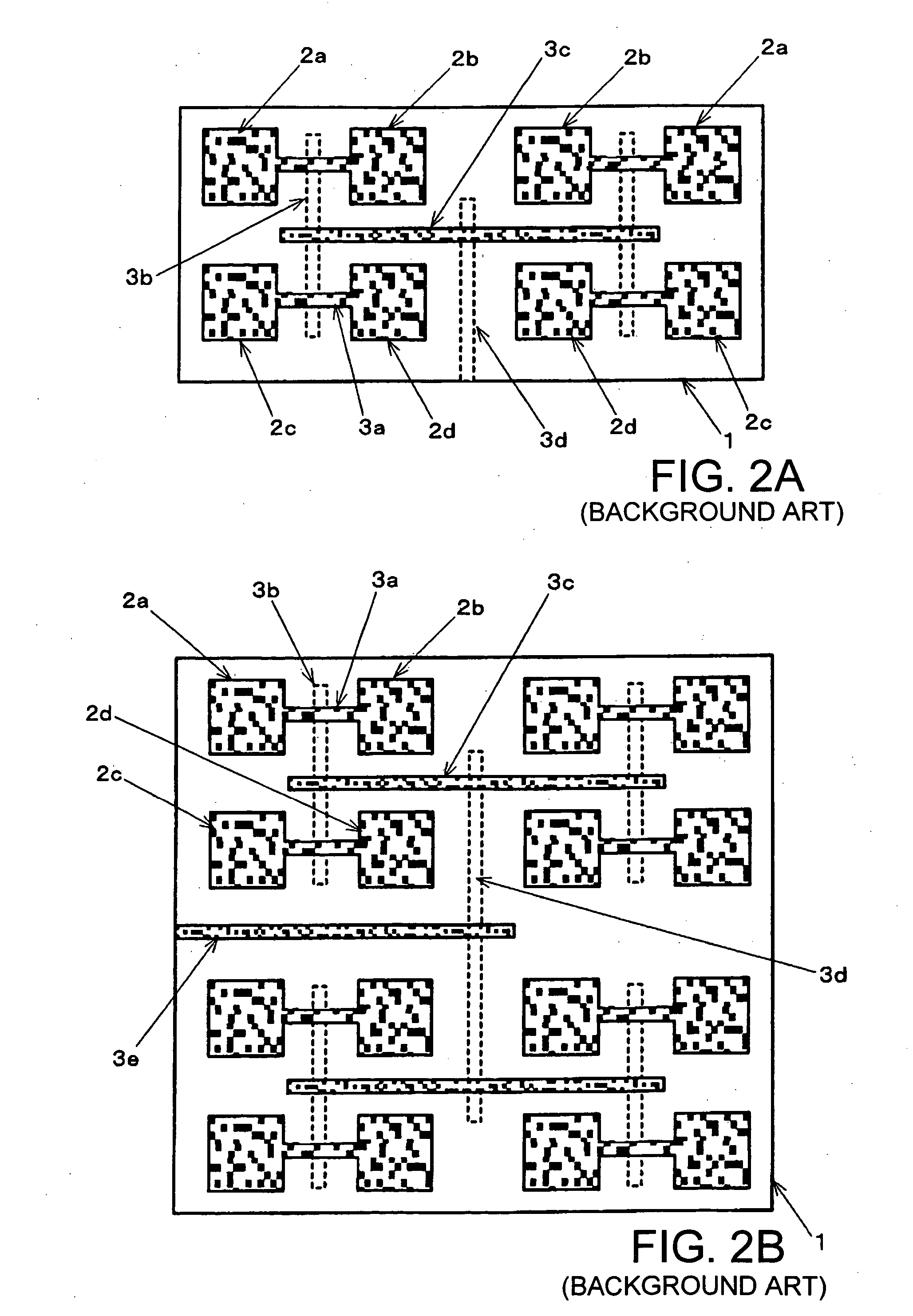Microstrip line type planar array antenna
a planar array and microstrip line technology, applied in the direction of individual energised antenna arrays, resonant antennas, antenna earthings, etc., can solve the problems of increasing the number of basic units described above, narrow frequency band width, and feeding loss, so as to reduce the number of powered antenna elements, increase the electromagnetic field intensity, and facilitate electromagnetic coupling
- Summary
- Abstract
- Description
- Claims
- Application Information
AI Technical Summary
Benefits of technology
Problems solved by technology
Method used
Image
Examples
first embodiment
[0059]FIGS. 4A to 4C illustrate a microstrip line type planar array antenna according to the present invention and show the construction of the basic unit used in this planar array antenna. It should be noted that, in FIGS. 4A to 4C, those parts which are identical to those shown in FIGS. 1A to 1C are denoted by identical reference characters and the duplicate explanations thereon are simplified.
[0060] In the basic unit shown in FIGS. 4A to 4C, first and second substrates 1a, 1b each consisted of a dielectric material are stacked and constitutes multilayer substrate 5. On the plane sandwiched by first substrate 1a and second substrate 1b, that is, an intermediate layer, two pieces of powered antenna elements 2a, 2b are arranged at the positions corresponding to the both ends of one side of a geometric square, for example, a regular square, and two pieces of adjacent passive element 6c′, 6d′ are arranged at the two remaining apexes of the regular square. In the example shown in the f...
second embodiment
[0076]FIGS. 8A to 8C illustrate a microstrip line type planar array antenna according to the present invention and show the construction of the basic unit used in this planar array antenna. It should be noted that, in FIGS. 8A to 8C, those parts which are identical to those shown in FIGS. 4A to 4C are denoted by identical reference characters and the duplicate explanations thereon are simplified.
[0077] Also with the second embodiment, in the basic unit, first and second substrates 1a, 1b each consisted of a dielectric material are stacked and constitute multilayer substrate 5. Ground conductor 4 is provided on the reverse surface of multilayer substrate 5. On the plane sandwiched by first substrate 1a and second substrate 1b, that is, an intermediate layer, powered antenna elements 2a, 2b are arranged at the positions corresponding to the midpoints of the longer sides of a rectangle, respectively, and adjacent passive elements 6c′, 6d′, 6e′, 6f′ are arranged at the positions corresp...
third embodiment
[0083]FIGS. 10A to 10C illustrate a microstrip line type planar array antenna according to the present invention and show the construction of the basic unit used in this planar array antenna. It should be noted that, in FIGS. 10A to 10C, those parts which are identical to those shown in FIGS. 4A to 4C are denoted by identical reference characters and the duplicate explanations thereon are simplified.
[0084] Also with the third embodiment, in the basic unit, first and second substrates 1a, 1b each consisted of a dielectric material are stacked and constitute multilayer substrate 5. Ground conductor 4 is provided on the reverse surface of multilayer substrate 5. On the plane sandwiched by first substrate 1a and second substrate 1b, that is, an intermediate layer, powered antenna elements 2a, 2b are arranged at the positions corresponding to both ends of a diagonal of a regular square or a rectangle, respectively, and adjacent passive elements 6c′, 6d′ are arranged at the positions corr...
PUM
 Login to View More
Login to View More Abstract
Description
Claims
Application Information
 Login to View More
Login to View More - R&D
- Intellectual Property
- Life Sciences
- Materials
- Tech Scout
- Unparalleled Data Quality
- Higher Quality Content
- 60% Fewer Hallucinations
Browse by: Latest US Patents, China's latest patents, Technical Efficacy Thesaurus, Application Domain, Technology Topic, Popular Technical Reports.
© 2025 PatSnap. All rights reserved.Legal|Privacy policy|Modern Slavery Act Transparency Statement|Sitemap|About US| Contact US: help@patsnap.com



